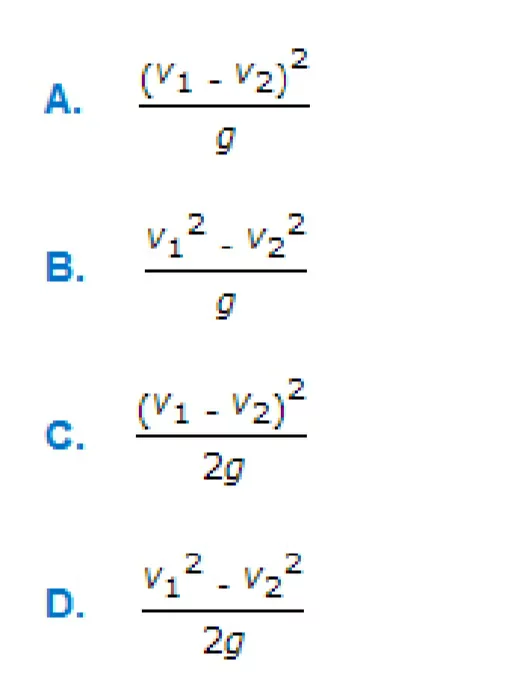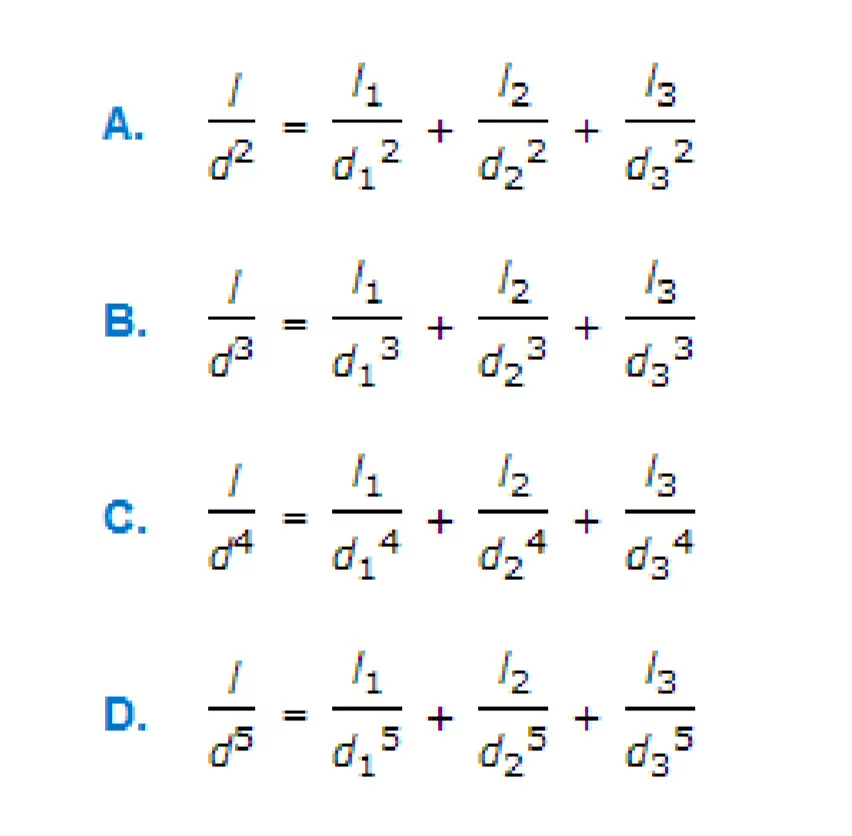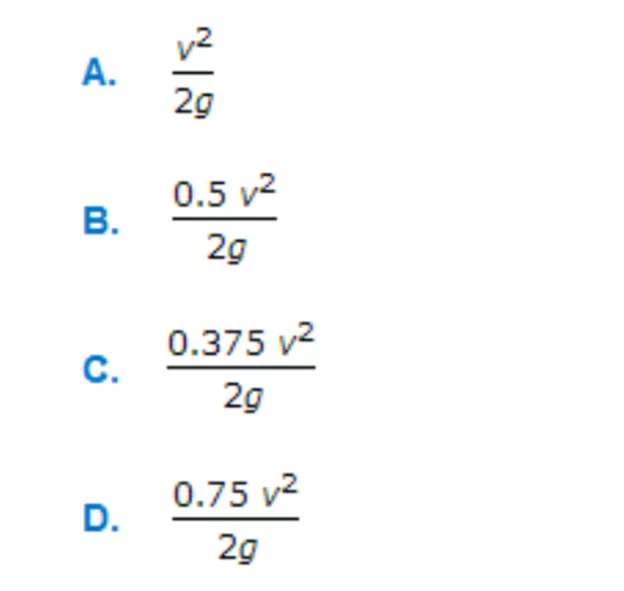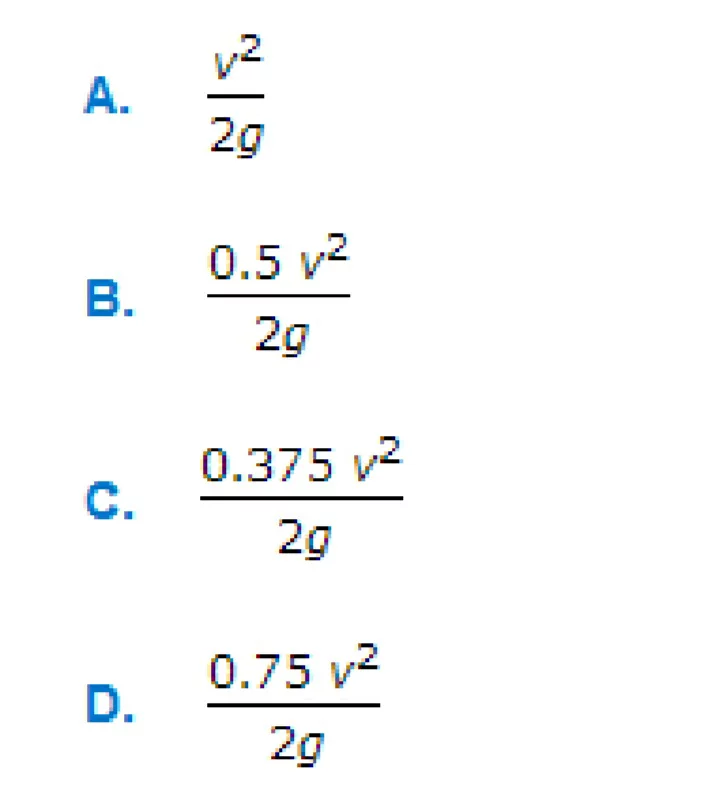Fluid Mechanics & Hydraulics (3140611)
MODULE 5: FLOW THROUGH PIPES
1. The length AB of a pipe ABC in which the liquid is flowing has diameter (d1) and is suddenly enlarged to diameter (d2) at B which is constant for the length BC. The loss of head due to sudden enlargement is
Answer: Option C
2. Coefficient of contraction is the ratio of
A. actual velocity of jet at vena contracta to the theoretical velocity
B. loss of head in the orifice to the head of water available at the exit of the orifice
C. actual discharge through an orifice to the theoretical discharge
D. area of jet at vena contracta to the area of orifice
Answer: Option D
3. The Reynold’s number of a ship is __________ to its velocity and length.
A. directly proportional
B. inversely proportional
Answer: Option A
4. Which of the following is an example of laminar flow?
A. Under ground flow
B. Flow past tiny bodies
C. Flow of oil in measuring instruments
D. all of these
Answer: Option D
5. The total energy line lies over the hydraulic gradient line by an amount equal to the
A. pressure head
B. velocity head
C. pressure head + velocity head
D. pressure head – velocity head
Answer: Option B
6. The maximum efficiency of transmission through a pipe is
A. 50%
B. 56.7%
C. 66.67%
D. 76.66%
Answer: Option C
Maximum loss due to friction is H/3, where H is the total head available.
So maximum efficiency = (H-H/3)/H = 2/3 = 0.6667 = 66.67%.
7. A siphon is used to connect two reservoirs at different levels intervened by a high ridge.
A. True
B. False
Answer: Option A
8. The loss of head due to an obstruction in a pipe is twice the loss of head at its entrance.
A. Agree
B. Disagree
Answer: Option A
9. A compound pipe of diameter d1, d2 and d3 having lengths l1, l2 and l3 is to be replaced by an equivalent pipe of uniform diameter d and of the same length (l) as that of the compound pipe. The size of the equivalent pipe is given by
Answer: Option D
10. When the pipes are in series, the total head loss is equal to the sum of the head loss in each pipe.
A. Yes
B. No
Answer: Option A
11. The efficiency of power transmission through pipe is (where H = Total supply head, and hf = Head lost due to friction in the pipe)
Answer: Option A
12. If an incompressible liquid is continuously flowing through a pipe, the quantity of liquid passing per second is different at different sections.
A. True
B. False
Answer: Option B
13. The hydraulic gradient line may be above or below the centre line of the pipe.
A. True
B. False
Answer: Option B
14. A compound pipe is required to be replaced by a new pipe. The two pipes are said to be equivalent, if
A. length of both the pipes is same
B. diameter of both the pipes is same
C. loss of head and discharge of both the pipes is same
D. loss of head and velocity of flow in both the pipes is same
Answer: Option C
15. An air vessel is provided at the summit in a syphon to
A. avoid interruption in the flow
B. increase discharge
C. increase velocity
D. maintain pressure difference
Answer: Option A
16. A flow through a long pipe at constant rate is called
A. steady uniform flow
B. steady non-uniform flow
C. unsteady uniform flow
D. unsteady non-uniform flow
Answer: Option A
17. The hydraulic gradient line may be above or below the centre line of the pipe.
A. True
B. False
Answer: Option B
18. In an external or internal mouthpiece, the absolute pressure head at vena contracta is zero when atmospheric pressure head is 10.3 m of water.
A. Correct
B. Incorrect
Answer: Option A
19. The loss of head at entrance in a pipe is (where v = Velocity of liquid in the pipe)
Answer: Option B
20. The water hammer in pipes occurs due to sudden change in the velocity of flowing liquid
A. Agree
B. Disagree
Answer: Option A
21. The velocity corresponding to Reynold number of 2000 is called
A. sub-sonic velocity
B. super-sonic velocity
C. lower critical velocity
D. higher critical velocity
Answer: Option C
22. The loss of head at exit of a pipe is
Answer: Option A
23. The flow in a pipe is laminar, when Reynold number is less than 2000.
A. True
B. False
Answer: Option A
24. The power transmitted through the pipe is maximum when the head lost due to friction is equal to
A. one-fourth of the total supply head
B. one-third of the total supply head
C. one-half of the total supply head
D. two-third of the total supply head
Answer: Option B
25. The total energy line lies over the centre line of the pipe by an amount equal to
A. pressure head
B. velocity head
C. pressure head + velocity head
D. pressure head – velocity head
Answer: Option C
26. The hydraulic mean depth or the hydraulic radius is the ratio of
A. area of flow and wetted perimeter
B. wetted perimeter and diameter of pipe
C. velocity of flow and area of flow
D. none of these
Answer: Option A
27. The hammer blow in pipes occurs when
A. there is excessive leakage in the pipe
B. the pipe bursts under high pressure of fluid
C. the flow of fluid through the pipe is suddenly brought to rest by closing of the valve
D. the flow of fluid through the pipe is gradually brought to rest by closing of the valve
Answer: Option C
28. The value of coefficient of discharge is __________ the value of coefficient of velocity.
A. less than
B. same as
C. more than
Answer: Option A
Because of Cd = Cc * Cv.
Cc is less and Cv is high and ultimately, Cd is less than the Cv.
29. Turbulent flow takes place at high velocities.
A. Agree
B. Disagree
Answer: Option A
30. The hydraulic mean depth for a circular pipe of diameter (d) is
A. d/6
B. d/4
C. d/2
D. d
Answer: Option B
Hydraulic mean depth = area of the flow/wetted perimeter,
M = d^2/4(d),
= d/4.
31. The hydraulic gradient line is always parallel to the centre line of the pipe.
A. Correct
B. Incorrect
Answer: Option B
32. The factional resistance of a pipe varies approximately with __________ of the liquid.
A. pressure
B. velocity
C. square of velocity
D. cube of velocity
Answer: Option C
33. In case of flow through parallel pipes,
A. the head loss for all the pipes is same
B. the total discharge is equal to the sum of discharges in the various pipes
C. the total head loss is the sum of head losses in the various pipes
D. Both (A) and (B)
Answer: Option D




